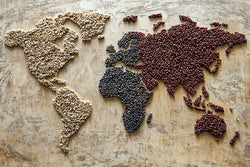The Ultimate Guide to the Coffee Regions: Origins, Flavours & Cultivation
Coffee is grown in a dazzling array of environments across the globe, from misty highlands to sun-drenched valleys. Each region’s combination of climate, soil, and cultural practices yields distinct coffee origin flavours that can surprise even the most seasoned coffee lover. This coffee regions guide will help you understand how geography shapes your morning brew, explore the best coffee-growing regions, and discover ways to enjoy them responsibly. Whether you’re a coffee connoisseur expanding your palate or simply eager to learn more about the world’s coffee-growing countries, this guide will deepen your appreciation for each sip.
Introduction to Coffee Regions
Coffee’s diversity is often overlooked. Many of us know coffees described as “chocolatey” or “citrusy,” but fewer realise those attributes reflect the coffee’s regional heritage. From the vibrant acidity of African coffee beans to the sweet, nutty characteristics found in Latin American coffee, the differences are profound. Yet, a coffee’s flavour doesn’t emerge by chance. Local climates, the altitude of coffee farms, and even soil minerals all play a role in determining the final cup.
In this journey, we’ll travel through the best coffee-growing regions worldwide, unveiling what makes each area special. We’ll also examine how altitude, processing methods, and terroir contribute to each coffee’s taste and aroma. Finally, we’ll address sustainability and ethical sourcing—crucial elements in preserving coffee’s future and supporting the farmers who produce it.
Ready to explore coffee by region, unearth coffee terroir secrets, and discover new favourites? Read on to understand the power of place in shaping every subtle nuance of your cup.
How Coffee Regions Affect Flavour
Most coffee growing countries lie within the “Coffee Belt,” a band around the equator where the climate suits coffee plants. However, variations in altitude, temperature, and even rainfall lead to unique flavour profiles. Here are the main factors:
-
Climate
Temperature & Rainfall: Coffee thrives in stable, moderate temperatures—usually 15–25°C. Rainfall patterns influence flowering and ripening, impacting sweetness or acidity in the beans.
Sunlight Exposure: Some farms rely on shade-grown techniques to moderate temperature and protect cherries from harsh rays, promoting slower maturation and more nuanced flavour.
-
Altitude
High-altitude coffee often has increased acidity and complexity. The cooler conditions slow a coffee cherry’s development, concentrating sugars and contributing bright, floral, or fruity notes.
Lower altitudes can yield coffees with heavier body and milder acidity.
-
Soil Composition
Minerals like phosphorus or potassium can accentuate particular taste notes. Volcanic soils, for instance, are prized for producing vibrant, lively coffees.
Rich, fertile soil often fosters stronger growth, though some stress on the plant (as found at high altitudes) can concentrate flavour compounds.
-
Processing Methods
Wet (Washed) Process: Cherries are de-pulped, fermented, and washed before drying, resulting in a cleaner, brighter cup.
Dry (Natural) Process: Cherries are dried whole, imparting sweeter, fruitier, and sometimes “funkier” notes due to longer contact with fruit sugars.
Honey Process: Partially de-pulped cherries create a balanced profile, combining elements of washed and natural processes.
The Key Coffee-Growing Regions of the World
Now, let’s journey across major coffee growing countries, each offering distinctive notes and experiences. Though far from exhaustive, these highlights showcase the best coffee-growing regions globally.
Latin America
Colombia: Balanced & Fruity
-
Flavour Profile: Often medium-bodied with clean acidity, featuring fruity or nutty notes.
-
Why It’s Special: High altitudes in the Andean mountains lead to well-rounded coffees with a sweet brightness. Rainfall is evenly distributed, ensuring cherries mature gradually.
-
Try If You Like: A balanced cup you can enjoy black or with milk. Great for beginners exploring single-origin coffees.
Costa Rica: Bright & Citrus
-
Flavour Profile: Tangy citrus notes and a lively acidity, finishing clean.
-
Why It’s Special: Stricter farming regulations and smaller-scale farms often yield consistent quality. Many regions are 1,200m+ above sea level, intensifying acidity.
-
Try If You Like: Crisp, refreshing coffees that highlight bright fruit or floral hints.
Brazil: Nutty, Chocolatey, Low Acidity
-
Flavour Profile: Think chocolate, nuts, and sometimes a sweet peanutty characteristic. Typically lower in acidity.
-
Why It’s Special: As the world’s top coffee producer, Brazil’s diversity of microclimates means you can find both mass-market and speciality beans. Natural (dry) processing is common, resulting in a heavier body.
-
Try If You Like: A smooth, comforting coffee suited to espresso, milk-based drinks, or cold brew.
Guatemala: Rich, Spicy, and Complex
-
Flavour Profile: Frequently described as having bright acidity with a spicy, chocolaty complexity. Fruity notes can also appear.
-
Why It’s Special: Volcanic soil and mountainous terrain create microclimates that produce distinctive, flavour-dense beans.
-
Try If You Like: Complex, layered coffees that demand attention and deliver nuanced, sophisticated notes.
Africa
Ethiopia: Fruity, Floral, and Complex
-
Flavour Profile: Ethiopia is often cited as coffee’s birthplace, known for bright citrus, berry, or jasmine notes.
-
Why It’s Special: Heirloom varieties flourish in wild or semi-forested farms. Natural (dry) processing is common in areas like Yirgacheffe or Sidamo, contributing fruity depth.
-
Try If You Like: Light roasts that sparkle with fruitiness, ideal for pour-over.
Kenya: Bold Acidity & Berry-like Notes
-
Flavour Profile: Kenyan beans can be tangy, with blackcurrant or tomato-like sweetness, balanced by juicy acidity.
-
Why It’s Special: High elevations, rich soil, and exacting processing standards ensure consistent, high-quality harvests.
-
Try If You Like: Intensely bright cups, sometimes described as “winey,” perfect for filter methods.
Tanzania: Juicy & Fruity
-
Flavour Profile: Known for vibrant acidity and fruity elements, somewhat akin to Kenyan coffees but often slightly mellower.
-
Why It’s Special: Tanzanian beans are frequently grown near Mount Kilimanjaro. Their microclimate fosters distinctive berry or sometimes tea-like notes.
-
Try If You Like: Subtle fruit complexity with a pleasing tang.
Asia and Pacific
Indonesia (Sumatra): Earthy, Herbal, Full-Bodied
-
Flavour Profile: Sumatran coffees often feature earthy, spicy, or mushroom-like undertones, with low acidity and a heavy body.
-
Why It’s Special: The “wet-hulled” processing method unique to Sumatra accentuates bold, savoury elements.
-
Try If You Like: Dense, thick-textured coffees that excel as dark roasts or espresso bases.
Papua New Guinea: Smooth & Balanced
-
Flavour Profile: Often presents chocolatey, fruity, and sometimes floral hints, reminiscent of certain Jamaican or East African profiles.
-
Why It’s Special: PNG cultivates coffee in mountainous regions with rich soil, leading to gentle complexity.
-
Try If You Like: Balanced cups with moderate acidity and mild sweetness.
Other Notable Regions
Mexico: Light, Smooth, Nutty
-
Flavour Profile: Often mild with subtle nutty or chocolaty hints, usually lighter in body.
-
Why It’s Special: Smaller farms and cooperatives produce carefully tended beans that can be quite refined.
-
Try If You Like: A gentle cup that’s easy to drink throughout the day.
Honduras: Sweet, Mild, Caramel & Chocolate
-
Flavour Profile: Sweetness and mild acidity are common, with toffee-like or caramel notes.
-
Why It’s Special: Honduras has boosted its quality in recent years, resulting in more speciality coffee reaching global markets.
-
Try If You Like: Smooth, mellow coffees that pair well with milk or sweeteners.
Specialty Coffee Regions and Terroir
When we talk about specialty coffee regions, we’re referring to areas renowned for producing premium beans with distinctive characteristics. The concept of terroir—a term also used in wine—captures how environmental factors like soil type, altitude, and microclimate shape a coffee’s final taste.
What Is Terroir?
-
Terroir in coffee means the environment’s unique elements—soil minerals, weather patterns, altitude—imprint on the bean’s flavour. For instance, high-altitude Ethiopian coffee might express bright citrus or tea-like qualities, reflecting the plant’s slow cherry maturation in cooler air.
Famous Specialty Coffee Regions
-
Ethiopia: Often considered the heartland of coffee, it boasts an astonishing variety of heirloom beans. Microclimates across Yirgacheffe, Sidamo, or Harrar yield diverse, often floral or fruity nuances.
-
Colombian Highlands: Certain smallholder farms produce extremely high-scoring coffees, capitalising on volcanic soil and precise processing methods
-
Costa Rica’s Tarrazú Region: Known for refined acidity and sweet, clean cups. Stricter environmental regulations also encourage sustainable farming practices.
Flavour Profiles & Microclimates
-
Even within a single country, micro-regions can differ. A farm high on a mountain slope might produce markedly different notes than one lower down, thanks to microclimate variations.
-
Specialty coffee generally ranks high on a grading scale due to clarity, unique taste elements, and minimal defects.
Seeking out beans from these specialty coffee regions can offer a premium experience and a strong sense of place in your cup. Next time you shop for beans, look for roaster notes highlighting terroir and micro-lots to delve deeper into coffee’s fascinating diversity.
Ethical Sourcing and Sustainability in Coffee Regions
With increasing demand for coffee worldwide, sustainability and ethical sourcing have become pivotal. Different coffee growing countries face unique environmental and social challenges, making fair and responsible sourcing essential:
-
Fair Trade & Direct Trade
Fair Trade: Ensures farmers receive stable prices, aiming to reduce exploitation.
Direct Trade: Roasters work directly with farmers, forging closer relationships and often paying premiums that empower local communities.
-
Sustainability Efforts
Climate change threatens coffee yields, especially at lower altitudes. Many farms adopt shade-growing, water conservation, or soil rehabilitation practices to cope.
Organic or Rainforest Alliance certifications can signal eco-friendly farming that protects biodiversity and local ecosystems.
-
Certifications
Organic, Fair Trade, and Rainforest Alliance labels reassure consumers about farming ethics, but each focuses on different aspects—like reduced chemical use or improved farmer livelihoods.
By choosing ethically sourced beans, you support coffee-growing families and help safeguard the regions that produce our favourite brews. Look for roasters highlighting direct trade relationships or eco-conscious certifications, aligning your palate with sustainable values.
H2: How to Brew Coffee from Different Regions
Each region’s coffee demands a method that best highlights its inherent flavour. Here’s how to brew coffee from different regions for an optimal cup:
-
Light Roasts (e.g., Ethiopian, Kenyan)
-
Why Light Roast? To preserve fruity, floral notes.
-
Best Brew Methods: Pour-over (Hario V60, Chemex) emphasises brightness and clarity.
-
Tip: Use a slightly higher coffee-to-water ratio (1:15 or 1:16) and control your pouring speed for balanced extraction.
-
-
Medium Roasts (e.g., Colombian, Guatemalan)
-
Why Medium Roast? Showcases balanced sweetness and acidity.
-
Best Brew Methods: Drip coffee maker or AeroPress.
-
Tip: Medium roasts often shine in filter methods that highlight their inherent complexity without overshadowing subtle notes.
-
-
Dark Roasts (e.g., Brazilian, Sumatran)
-
Why Dark Roast? Enhances chocolatey, earthy notes and heavier body.
-
Best Brew Methods: French press or espresso accentuates rich, bold characteristics.
-
Tip: Watch for bitterness if brew time runs too long. Dark roasts require careful extraction to avoid harsh flavours.
-
Next time you select beans from a specific region, choose a brew method that complements its roast level. Experiment with small adjustments to grind size or brew ratio until you reveal the coffee’s true essence.
Embarking on Your Global Coffee Adventure
Coffee’s diversity flows from places rich in cultural heritage and distinct natural environments, each shaping the seed-to-cup journey. Whether you’re enjoying a floral Ethiopian brew or a robust Sumatran, recognising the role of altitude, processing methods, and climate can greatly enhance your enjoyment—and your respect for the craft.
Exploring coffee by region not only broadens your flavour horizons but also fosters a deeper connection to farmers and ecosystems worldwide. From bright African coffee beans to mellow Latin American coffee, there’s a vast array of choices waiting for your next cup.
Ready to discover new frontiers in your coffee routine? Try a sampler pack featuring various coffee origin flavours, or browse our ethically sourced collection from different coffee growing countries. Each sip is a journey—enjoy exploring!


